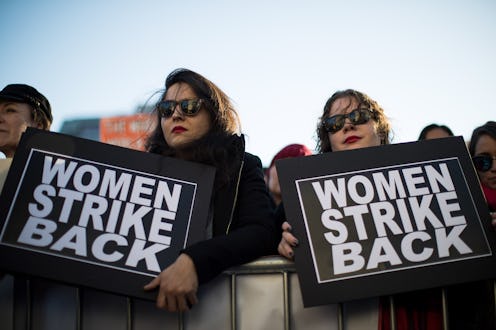News
How Many Women Went On Strike?

International Women's Day 2017 was marked this year by worldwide rallies, demonstrations, and events celebrating the accomplishments and contributions of women. But what got much of the country's attention was the planned nationwide strike in which organizers of January's Women's March called on women to take the day off from both paid and unpaid labor, avoid spending money, and wear red to show solidarity on March 8. Hopes were high that the strike would show people, and especially employers, everywhere just how enormously important women's labor is. But with IWD 2017 having come and gone, many are wondering just how many women did strike on A Day Without a Woman.
Participation in Day Without a Woman rallies and events seems to have fallen way short of the over 1 million who took part in the Women's March on Washington and its sister marches. But significant numbers did come out to show their support on March 8. Al Jazeera reports that about 1,000 people showed up to a Women's Day rally in New York City. While ABC News reports that in many other places like Los Angeles and Denver crowds numbered in the hundreds. Additionally, several U.S. schools were forced to close due to workers striking for Women's Day.
But, of course, not every woman was able to or wanted to participate in the strike. And a Day Without a Woman sparked many important conversations online about the inclusivity and/or exclusivity of the strike, how privilege factors into participation, and what other celebrations of women and their labor can look like.
Overall, there isn't a clear way to measure just how many women took the day off work on March 8. And conversations about the strike's effects and whether or not it was a success will likely continue on for a while. What we do have, though, are the projections of what would have happened economically had all women in the United States ceased doing paid labor on IWD 2017. According to the Center for American Progress, the country would have lost $21 billion in GDP without women's work.
Overall, while we may not know exactly how many women in the United States and worldwide took the day off work on IWD 2017, it's safe to assume that with this concerted effort, it was a much higher number than those who took work off last year.
Ultimately, the success of the strikes in the United States will be measured in just how much action women take in this country moving forward. If IWD 2018 rally and strike turnout ends up being larger than this year's (and if equal rights for women makes major legislative gains), I think we can count the awareness the 2017 strikes raised as a win. It'll just take some time to see.